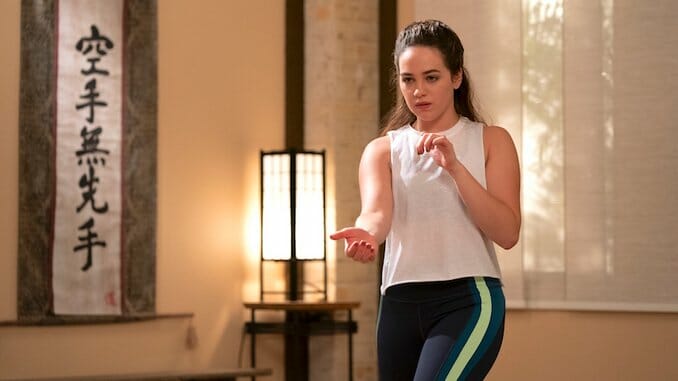Cobra Kai May Exude Masculine Energy, but Women Remain Its Secret Weapon
Photo Courtesy of Netflix
In karate—or any form of physical fighting, really—there exists a common phrase to describe one-on-one battles: “mano-a-mano.” Mano-a-mano is at the core of Netflix’s Cobra Kai, a Karate Kid spin-off that pits Johnny Lawrence (William Zabka) and Daniel LaRusso (Ralph Macchio) against each other once again. It’s a recurring theme in the series: two parties are always contending. Johnny versus Daniel. Miguel (Xolo Maridueña) versus Robby (Tanner Buchanan). Cobra Kai versus Miyagi Do. Even though mano-a-mano is often mistaken as a gendered term (man-on-man) and Cobra Kai feels like it could be a male-dominated show, neither is true.
Mano-a-mano simply means hand-to-hand. And hand-to-hand combat can involve anyone, women included! With nuanced heroines, stunning duels, and a boatload of concerned mothers, Cobra Kai pushes women to the center of the mat. They deserve our attention just as much as the Johnnys, the Daniels, and the Kreeses of the show.
From the very first episodes of Cobra Kai, it’s made clear that women are no longer mere onlookers of the dojo. Aisha Robinson (Nichole Brown) is one of the very first members of Johnny’s Cobra Kai studio, immediately wiping the floor with Miguel in a quick battle. Though Johnny initially protests the idea of a girl in his dojo, the message is clear: the women of Cobra Kai are willing to put up a fight for their love of karate.
The ending of the first season of Cobra Kai is unforgettable. Not only does the finale mark the grim resurrection of Sensei John Kreese, it also flings a new key player into the karate ring: Samantha LaRusso (Mary Mouser). Although the prodigal daughter long neglected her martial arts roots, her return to the mat is epic. Her sole karate move in Season 1—a dazzling flip in the very last moments of the finale—lends itself to the rest of Cobra Kai as we know it. As long as the Miyagi-Do stands, we truly have Sam to thank.
After jumping through many training sessions, a couple of boyfriends, and a traumatic fight sequence in the second season, this new season of Cobra Kai finds Sam back at square one. No more karate. She can’t even walk up the stairs of her high school, she’s so traumatized by her scarring battle. Sam’s conflict with the wounds of karate is unique to the rest of the show: none of the other characters seem to dwell too long on their traumas. Take Miguel, for example—even though he’s nearly paralyzed at the beginning of the third season, he’s still eager to fight by the final episode. Instead, Sam processes her relationship to martial arts with thoughtfulness and grace.
-

-

-

-

-

-

-

-

-

-

-

-

-

-

-

-

-

-

-

-

-

-

-

-

-

-

-

-

-

-

-

-

-

-

-

-

-

-

-

-








































